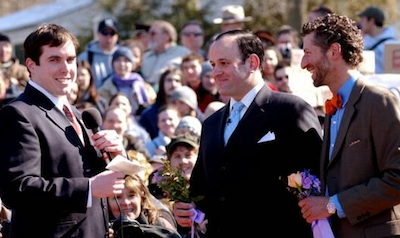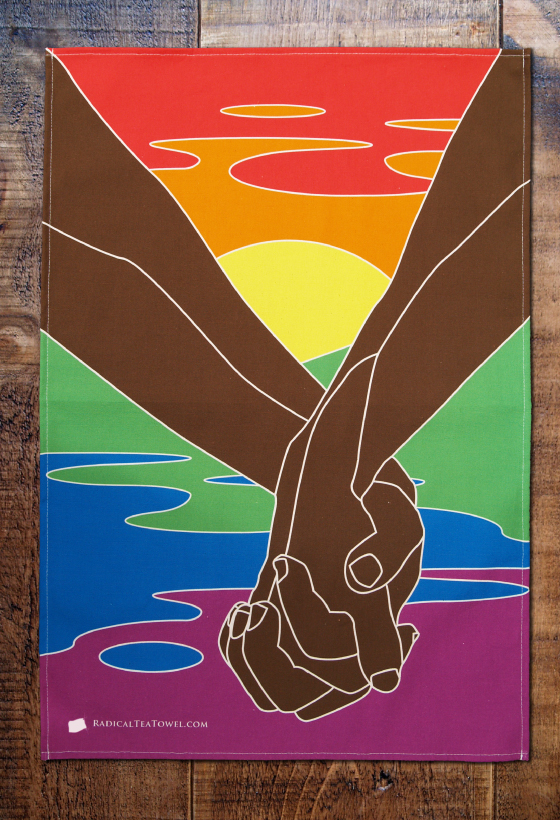The Long Road to Marriage Equality: Obergefell v Hodges
Posted by Matt on Jun 26th 2019
The anniversary of the 2015 Supreme Court decision legalizing marriage equality is a moment to acknowledge our place in history.
Marriage equality in the United States turns four today, with the anniversary of the 5-4 Supreme Court decision guaranteeing the equal right of same sex couples to marry under the Constitution’s 14th Amendment.
Handed down on June 26, 2015, the Court’s ruling in Obergefell v Hodges established marriage equality as the law of the land, by requiring states to issue marriage licenses to willing couples regardless of their sexual orientation.
The movement to legalize equal marriage remains one of the most remarkable transformations of our times.
If Stonewall is the origin tale of the modern day LGBTQ civil rights struggle, the 21st century battle for marriage equality is its latest epic chapter.
It's easy to forget how far we've come since the early 2000s.
An Act of Civil Disobedience
On a bright Sunday morning in the early spring of 2004, members of the Westboro Baptist Church — those sad, crazy religious extremists who go around the country picketing funerals and carrying terrible signs — showed up to a small town in Upstate New York.
Earlier that winter a handful of mayors across the United States had begun directing their cities to issue marriage licenses to same sex couples, in an extraordinary act of civil disobedience.
The most highly publicized example took place in San Francisco, where Mayor Gavin Newsom (now California’s governor) successfully directed the city clerk to authorize about 4,000 marriage licenses over a one month period before the California Supreme Court stepped in.
Across the country in tiny New Paltz, NY, Jason West, the town’s 27 year-old Green Party mayor, had performed a similar action — marrying 25 local couples before receiving a court injunction, racking up 18 misdemeanor charges in the process.
Above: Mayor Jason West presiding over a wedding in New Paltz, February 2004
And now the Westboro Baptist Church was here, to tell the town and everyone who lived there that they were all going to hell for the mayor’s unforgivable sin of attempting to treat people equally.
Standing Up for the Same Love
I attended the counter protests that day with my best friend — we were 16 at the time. His mom, a local English professor, activist, and proud gay woman herself, had driven us all there from a half hour away to show us what civil resistance looked like.
I don’t remember many details, however I do remember the way New Paltz’s colorful collection of students, tye-dyed hippies, local business owners, and regular folks confronted this group of weirdos with “God Hates Fags” signs — not with sticks and stones but with those timeless Beatles lyrics: “All you need is love.”
Above: Our original design celebrating love and equality around the world
The town’s lead newspaper headline the next day — “Hate meets its match in New Paltz” — said it all.
Similar demonstrations and counter demonstrations took place around the country during those heady days, and for a brief moment it appeared as if America was on the cusp of something big.
A Dream Deferred — But Not For Long
Alas, in 2004 it was not meant to be.
By summer, the marriages in New Paltz, San Francisco, and other places whose mayors had joined in the uprising were nullified by the courts.
Later that year, George W. Bush was re-elected on a wave of conservative voter turnout, fueled by right-wing ballot initiatives which enacted constitutional amendments banning marriage equality in several key states.
Nobody would have predicted then that within 11 years marriage equality wouldn’t be some pie-in-the-sky dream, but an actual reality for millions of Americans.
It doesn’t take away from the many remaining injustices against the LGBTQ community — or the ways in which the same US Supreme Court has trampled over voting rights and access to women’s health care in recent years.
But just as we progressives are right to challenge every injustice, we should take a moment to recognize and celebrate progress every once in a while, too.
As Mayor West of New Paltz said in the New York Times back in 2004, amidst a flurry of publicity after the 25 weddings:
“Activism doesn't begin in the 60’s. There's the labor movement in the 30's. There's anarchism in the early part of the last century. The populist movement in the 1880's. Reconstruction. The suffragists, and all the way back to the Revolutionary War. It's all part of the same movement.''
For the millions of people in America (and around the world) whose love is no longer considered second class, the right to equal marriage is far from trivial.
It's an inspiration to keep challenging other stubborn areas of the status quo where change may be closer than we think.
This week, let’s take a moment to appreciate our historical place in the movement.


